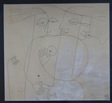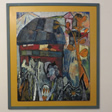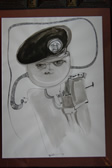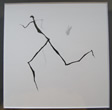|
In 1991 there was a party at Iwalawa Haus to celebrate Ulli’s seventieth birthday, and it more or less coincided with a conference on Literary Biography. Georgina felt that not enough was being done to honor Ulli, and I foolishly suggested that a ‘Life and Times of Georgina and Ulli’ be undertaken as there were all too many misrepresentations floating about. Few people knew much about their early years. Rather than accepting my recommendation of biographer, however, Ulli insisted that I take on the project. I strongly suspected that such a project couldn’t possibly work out. The bargain was that Geogina and I cook on alternate weeks and together record their stories. When I had a reasonable amount of material, I was to show them an edited version and let them decide whether to proceed or not. Interim we had many splendid evenings; dining well, drinking overmuch, and swapping yarns. The edited transcripts were denied, however; “That’s not what we said”. “That’s not what happened”.
It is impossible to judge which of them is the better narrator. Both are accomplished, but they differ in that Ulli’s have a larger cross-cultural sweep and Georgina’s are based in the particularity of observation and detail. For example Ulli’s memories of growing up near Berlin in the 1920s, a doctor and musician’s son, originally named Horst Ullrich Cohen. The family fled to Palestine shortly after Hitler’s rise to power at his mother’s insistence. She was German, not Jewish, and as he told the story (I paraphrase): I know my people and this is a dangerous situation. Then followed British detention centers (even sharing a cell with members of the Stern gang), and eventual re-invention on horseback as a show-jumper are truly amazing. (His aunt had been a fine horsewoman and taught him, as a boy, to love riding.) Later came salvation as a student of phonology in London, a spell of teaching handicapped children, meeting Susanne Wenger, his first wife (an Austrian artist with one eye one color, the other another) in Paris, and a university job in extra-mural Studies at Ibadan.
Georgina’s background was quite different. In adulthood she chose to re-name herself, never having been comfortable with being called Muriel. “Georgina suits me better” she said on several occasions. For the Beiers’ names were important signifiers. Their elder son is called Sebastian (Saba, to the family), and his younger brother also has a biblical name as well as one in Yoruba –– Lazarus Olatunji (‘Raised from the dead’ and ‘Grandfather has returned’). Sebastian takes after the maternal line, but ’Tunji looks very like his father.
Georgina’s parents were decidedly English, working class, both kind and gentle. Her father drove a horse-drawn milk-float for much of his life and in old age, could see but dimly. Her mother’s mind was ever fanciful. I was very pleased to meet them when they visited Bayreuth. Georgina, too, had imagination as well as determination and put herself through art school on the back of a sewing machine. She even taught me to use one when I had little money and had foolishly moved into a seven-room apartment which badly needed curtains, drapes, and bedspreads.
Georgina also ended up in Nigeria, but in the North (Zaria) where her first husband, whom she had met at art school, held a university post. After leaving him and taking refuge in Sabon Gari (The quarter of foreigners), she often talked about the tolerance and acceptance she found there and her sense of identity in a culture which prized individuality and personal dignity. Her experience was very like that of Ulli’s in Ibadan, and Ede.
They met quite by chance and immediately recognized one another. Both were particularly adept at encouraging talent without imposing alien conventions and were brilliant at promoting public relations for the writers and artists they had so admirably nurtured. Both were subjective critics as well as creators in their several spheres. The various styles of contemporary Nigerian art, however, need be set side by side in order to establish a comparative context. To this end I include selected reproductions from my own collection in order to contrast them with paintings and drawings from both the Oshogbo (Yoruba) and Nsukka (Igbo) groups, not that they were the only centers of art production in Nigeria.
|
|

Georgina Beier (b. 1938)
Untitled. Ink on paper
1982. 37x41 cm.
|
|
Ulli inspired any number of projects, and I owe him much for a chance remark which led me to serious research for an essay, ‘Differing Ethnic Traditions within a National Literature’ (1984). He also gave Wole Soyinka the story-line for Death and the King’s Horseman, which he in turn had heard from the much underestimated Pierre Verger years before. When rehearsing student actors for the world premier at Ife, Soyinka asked me to teach them to waltz, but I declined as diplomatically as possible–– and not because I couldn’t. As performed by student actors the travesty waltz-scene was danced so woodenly and to the music of an army band so off-key that it constituted a hugely ironic coup de théatre.
*****
A diversion here begs to intrude itself. There is a side to Soyinka which is rarely mentioned, but deserves acknowledgement. Beginning with the undergraduate humor of The Interpreters (1965) and its philosophy of ‘voidency’ there is often a note of authoritarian machismo. He has always been known for his rapport with Ogun, god of iron and lord of the road, and I remember being invited to an all male party on the 7th day of the 7th month in 1977 at seven o’clock which featured a severed goat’s head, mid-table. His play, The Road, is an homage to Ogun, and at Ife he founded a posse of vigilantes who harrassed every-day drivers for days on end. I then rode an underpowed motorcycle, to and from the office so that my wife would not be house-bound, and was once driven into a ditch by a madman screaming, “We know you, we’ll get you”. Fortunately students showed me a back road to avoid being further molested.
The reach of the Ogun myth is well known. In early days at Ife I was driving, after dark, on the old road from Ibadan, and in one of the many villages hit a stray dog. Horrified, I leapt out and begged the villagers for a machette to put the howling beast out of its misery. They refused. “It’s a sacrifice to Ogun”. Of course the ‘road’ (forest path) connects civil/civic spaces –– market places in the purview of an Oba’s compound. Ogun is its natural patron.
Then there is the Verger affair. Pierre was a close friend and had lunch at my house on the day he was to return to Brazil after a year’s research fellowship at Ife. The University hoped to inherit his incomparable archive of medicinal herbs and lore (See Ewé, The Use of plants in Yoruba society. 1995, 744 pgs). Olabiyi Yai was also present as he had offered to drive le maitre to the Lagos airport. Little did I know that Yai had betrayed Verger to Soyinka as possessing a ‘stolen’, Ife bronze-head (presumably the antique artifact fabled to have been carried off by the Frobenius expedition at the end of the nineteenth century). Pierre was jailed in Lagos while Soyinka and his little band of Boy Scouts flew, foolishly, to Sao Paulo. Wole wrote this up in his third volume of autobiographies as a great joke. The bronze head which Yai had earlier seen in Pierre’s flat turned out to be a copy bought at the British Museum’s tourist shop. Mercifully the archive retuned to Brazil and remains there.
For Verger that betrayal wasn’t much of a joke, and for a time he thought I was an accomplice, which, mistakenly, threatened a cherished friendship. He finally understood that I had had nothing to do with that absurd farce and, later, well into his nineties, invited me to join him at a retrospective exhibition of his photographic work at Karlsruhe. Pierre was ever charming, and I remember fondly one of his wilder dinner parties at Ife where my wife astonished him by out-drinking everyone aboard. As we left he kissed her hand and murmured: “Madame, j’admire votre capacité”.
Back to Soyinka –– and the spectre of a secret, student society running amok (1979). Campus rumor had it that Wole was the instigator, and the then Vice Chancellor invoked a committee to investigate the matter –– naming me as chairman. We took the mandate seriously and found no ground for the accusations. Our decision, however, was set aside by the registrar (an autocrat who had a very personal and prejudiced agenda). I protested vigorously and sent a copy of my official letter to Wole which he later made public. Earlier, that same registrar had denied my appointment of a highly qualified teacher in the remedial English program on the grounds that he believed her to be of questionable moral character –– as though his petty and personal views outweighed professional qualifications. However ideal Ulli Beier believed traditional Yoruba social norms to be, day to day politics certainly were no longer congruous with that now-mythical model.
*****
|
|

Muraina Oyelami (b. 1940)
Untitled. Oil on pressboard
1987. 120x100 cm.
|
|
Ulli honestly believed that same-sex relationships did not exist in his Africa, rather than that they were not tolerated. Offenders, when either suspected or found out, ended up with spikes in their skulls. His idealization of traditional culture led, inevitably, to other contradictions.
A young playwright whose father was Yoruba and mother Irish, whom I had met at Cambridge, turned up in Berlin for an opening performance of one of his works and wanted to visit Bayreuth. I arranged that he give a talk at Iwalewa Haus where I happened to sit next to the Beiers. Five or ten minutes into the presentation Ulli muttered darkly, “That boy doesn’t even know his own compound” and slammed out of the room. For someone who encouraged cross-cultural interaction, his strong, and uncalled for, reaction still baffles me.
Then too there is the question of his style of administration and relationship with colleagues (Assistenten). Such contracts in Germany are for three-year periods and normally renewed for another three. Only in one case was there a renewal, and no advanced warning of either inadequacy or imminent job-loss was ever offered those who didn’t live up to an unknown, set standard. Another interpretation might be that he was anxious about potential rivals. In any case Ulli had the power to do as he liked, but the arbitrary manner of doing it was not altogether admirable.
However, Beier was a connoisseur –– collector, curator promoter, etc., as well as acting at large as an art dealer. The spectrum when judging dealerships runs from idealism to roguery, and there are many historic precedences. In this case not much is known about the acquisition of the Iwalawa Haus collection nor of transactions with the various private enthusiasts who bought through him. I do, however, remember something of a brush with Peggy Harper in the early days of Iwalawa Haus who was selling a large Twins Seven Seven painting, and thought that she was being scalped. I declined, as politely as possible, to intervene. It was no secret that Peggy had always been rather difficult to deal with.
Georgina’s workshops in Oshogbo did give rise to the Oshogbo School, but her methodology was to allow participants to develop personal themes and individual styles. The enterprise started out strongly enough, but some of the artists limply repeated themselves rather than develop their talent. Muraina Oyelami and Rufus Ogundele were arguably the best among them, and neither was much influenced by Georgina’s themes and style. It is puzzling, however, that Bintu, the youngest wife of Twins Seven Seven, is so overlooked. As art, her batiques are admirable.
When Rufus was last in Bayreuth, as visiting artist at Iwelaya Haus, he held a valedictory exhibition as had Muraina, Obiora Udechukwu and, latterly, Marcia Kure. Fortunately, I arrived early and Georgina was waiting for me. Without a word she took me by the hand and led me to a further room, pointed to a painting and said: “Buy that one”. She was quite right –– it was the best on view. Georgina was always of good taste.
The last time she visited Bayreuth and that was long after the Beiers had returned to Australia, she stopped by to say goodbye. As she left she noticed a necklace of South-Sea Island, wild-boar’s teeth and tiny shells looped around a Qing, porcelain cannister on a table near the door. She stopped and exclaimed: “That’s beautiful. Where did you get it? It’s Papua New Guinea. They’re very rare and that one must be worth thousands”. Actually the necklace is Tahitian, and I had to confess: “Georgina, you gave it to me when you moved back to Sydney”.
*****
|
|

Rufus Ogundele (1946-1996)
Untitled. Oil on pressboard
1988. 38x47 cm.
|
|
The last words come from, and of, Georgina and Ulli themselves. The following quotations are from the abandoned biography.
Georgina
I’ve always wanted to make pictures. I’ve done it since I was a kid. […] I didn’t really have any formal education in art. When I was eleven, I wanted to draw beefeaters, they had such beautiful uniforms, all scarlet and gold. In a way I educated myself, but I really think that it was forced on me.
*
Have you ever watched those old geezers in white who bowl on the green? Those black balls and the one with the white dot on it, they make such lines on the smooth grass; it’s just like an engraving. The lines are perfect. Just watching the balls move and visualizing it over again is a fantastic education. Watching things teaches you to draw […]. Bowling is beautiful –– it’s clean and the green is long, not all cramped up like billards, but with a beautiful swing to it. That was the closest I could get to perfect peace.
*
When I was about thirteen, I went to the Wimbledon art school on Saturday mornings. I wanted to do something about art, but didn’t quite know how to go about it. I thought that people in the colleges must know. Of course, they didn’t, because it’s something you have to discover in yourself.
*
I can’t teach anybody I don’t respect and I can’t force somebody to draw like me. If they begin imitating someone else, you have to tell them straight off. You have to be quite cruel, actually, and tell them that they have to follow their own character […]. What I really liked about Nigeria was the openness of imagination –– people there weren’t stifled.
*
Maurice Godelier invited us to his place [in the highlands of Papua New Guinea] –– that must have been around 1968, and we flew in on a tiny, little airplane that landed with its nose right up against a mountain. Then we had to pull ourselves up that hill for five kilometres, and, because of the heavy rain and mist, it was thick, heavy mud all the way, like slippery clay. I had the baby [Sebastian] on my back, and when we got there, I saw that the farms were fenced in and the pigs ran free. The people were so elegantly dressed. The men had belts of string. Fine, hand woven string of forty strands and every knot the size of a pin-head in perfect rows. I sat on a bench to rest. One of the men who’d been sitting there told me to stay, but I realized that it was their place and I shouldn’t be there. I got off the bench pretty damn sharp. Then I saw the women who were dressed in dark capes and hiding in the trees –– literally hiding. I could see two trees, and then a shape, and then an eye coming out of the tree. It was so quiet and so hard to see them.
*****
|
|

Obiora Odechukwu (b. 1946)
"What the serpent did not say"
Ink & wash on paper
1989. 45x34 cm.
|
|
Ulli
Here follow the opening speeches of Scene I between Obatala (Oba Ife & God of Creation) and his wife, which constitutes a praise poem. Yam is a tuber and a staple of Yoruba cuisine. The dish referred to is egusi stew.
In the preface to the Heineman publication of The Imprisonment of Obatala (1966) Ulli wrote of himself in the third person.
There is no doubt that Obatunde Ijimire [Red Monkey] was directly inspired by [Duro] Ladipo’s plays. For a brief time, in fact, he was a member of Ladipo’s theatre company but soon decided that acting was not really his line. He had been interested in writing for a long time and had tried his hand with English short stories in the extra-mural writer’s workshop in Oshogbo. At the time his tutor’s advice to write in his native Yoruba tongue did not seem to click with him. But then the experience of Oba Koso suggested a new medium.
The following dialogue is between Yemanga and her husband, Obatala:
Yemanja (singing): Yam yam yam
You are whiter than the cattle egret
Whiter than teeth
Whiter even than the gown of Obatala.
Yam O yam O yam
You have a cap of meat
You have a gown of bitter leaf
You have trousers of fish.
Yam O yam O yam.
Obatala : So the new yam has come again
Whiter than teeth, whiter than salt,
Whiter than eyeballs, Whiter than the beads in my crown.
Yam :
You have the power to turn a wise man into a fool.
You cause the newly wedded wife to lose her manners.
The modest man unbuttons his shirt, his eyes grow wide
The new yam knows no difference between beggar and king
Between the thief and the rich man, between man and God :
You turn them all greedy alike.
*****
Both Georgina and Ulli ate of the new yam and their lives were changed forever.
|
|

Marcia Kure (b. 1970)
"Political leaders - Babangida"
Ink & wash on paper
1997. 14x14 cm.
|